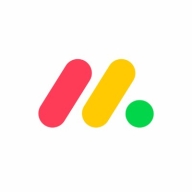

Asana and monday.com are major players in the project management category. While both have unique strengths, Asana's user-friendly design and integration versatility make it highly appealing for team collaboration, whereas monday.com is often favored for its powerful automation and customization capabilities.
Features: Asana's standout features include its intuitive Kanban board, robust integrations, and the user-friendly interface that ensures easy team communication. Real-time updates provide seamless task management and clear visibility of project progress. monday.com offers sophisticated automation, customizable dashboards that provide valuable insights, and expanded reporting features to accommodate complex project needs.
Room for Improvement: Asana could improve its task dependency management and expand its integration capabilities to optimize workflows further. Its calendar needs better customization options. monday.com users would benefit from enhanced automation features, advanced time tracking, and a more refined CRM system. There is also a desire for improved integration with popular tools like Google Calendar and more intuitive mobile interfaces.
Ease of Deployment and Customer Service: Asana provides flexible deployment options including hybrid and public cloud environments suited for diverse business needs. Its customer service is generally satisfactory, though users desire better community support and comprehensive tech assistance. In contrast, monday.com impresses with an intuitive setup and flexible cloud options, drawing praise for its responsive and accessible customer service.
Pricing and ROI: Asana's pricing is considered reasonable, offering multiple subscription tiers to fit different needs, although some users find it a bit steep relative to feature content, yet ROI is often seen as positive due to productivity gains. monday.com, while pricier particularly at enterprise levels, is deemed a worthwhile investment for its extensive features and scalability, with significant perceived value especially when advanced capabilities are fully utilized.
However, due to its pricing, I need to be careful about adding each user and feature.
The technical support is of high quality.
I would rate their customer service a ten.
Asana is quite stable; it is a tool I can trust.
It would be easier if I could assign tasks directly from my email without needing to open Asana.
It would be beneficial to have a native option for Asana to create tickets so we could move away from our main ticketing tool.
The need for a stable connection is critical as there are network issues that slow our processes down.
I would like to have the ability to create more than two levels of subtasks in monday.com.
To add one user is expensive, which makes me cautious about upgrading or adding more users.
It is quite expensive.
Asana's automation allows me to automate deadlines and send notifications to the right people about approaching deadlines.
Asana provides automation because we receive these updates the moment they happen without anyone needing to tell us they completed tasks or moved on to others.
monday.com saves time and gets everyone on the same page within my team.
monday.com helps in quick decision-making by facilitating communication on the go through the comment section and email alerts when someone comments.
monday.com makes it very easy to input any information.
| Product | Market Share (%) |
|---|---|
| monday.com | 6.9% |
| Asana | 4.1% |
| Other | 89.0% |


| Company Size | Count |
|---|---|
| Small Business | 38 |
| Midsize Enterprise | 7 |
| Large Enterprise | 6 |
| Company Size | Count |
|---|---|
| Small Business | 177 |
| Midsize Enterprise | 25 |
| Large Enterprise | 21 |
Asana is web-based software-as-a-service that helps teams coordinate and manage their work. It helps companies move faster by making sure everyone knows the team’s plan and process and who is doing what by when.
Each user can create projects using a list, board, calendar, or timeline view. Within each project, users can add tasks, subtasks, sections, comments, attachments, start and due dates, and custom fields. Project and task followers get notifications on changes or comments on the project and/or task in their Inbox. Individual users can see all of the tasks they're responsible for across all of their projects in a view called My Tasks.
Asana is available in English, French, Spanish, German, and Portuguese.
Monday.com enhances project management with automation, customization, and a user-friendly design, featuring Gantt charts, real-time updates, and extensive tool integrations.
Monday.com offers automation, customization, and user-friendly interfaces to improve project management capabilities. Its features, including Gantt charts, real-time updates, and integrations with tools like Slack and Google Suite, help teams streamline workflows. Users benefit from color coding, task assignments, subitems, and dashboards for a comprehensive project overview. Notifications, file-sharing, and forms increase collaboration, while templates simplify processes. However, it requires enhancements in user experience, speed, and mobile features. Challenges include limited boards, excessive notifications, and integration issues with Google Calendar and QuickBooks. Businesses use Monday.com for CRM tasks, sales tracking, marketing, and creative projects across fields like architecture, biotech, and nonprofits.
What are the key features of Monday.com?In industries like architecture, biotech, and nonprofit, Monday.com facilitates communication, task tracking, and collaboration for remote teams. It is commonly utilized for CRM, sales tracking, marketing, and creative project management, ensuring workflow organization and client management are streamlined.
We monitor all Project Management Software reviews to prevent fraudulent reviews and keep review quality high. We do not post reviews by company employees or direct competitors. We validate each review for authenticity via cross-reference with LinkedIn, and personal follow-up with the reviewer when necessary.